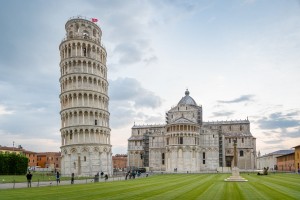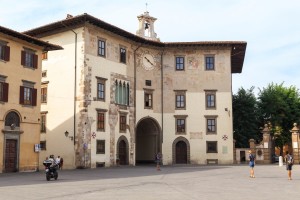When it comes to Italian cities of arts, Pisa’s usually right up there. The stunning city in northern Tuscany, divided by the river Arno, is known around the world for its Leaning Tower. However, that’s certainly not everything this once powerful, influential maritime republic has in store for you. It is home to one of the oldest UNESCO World Heritage Sites on Italian soil, respected colleges, and lavish celebrations. From tourism hub to university city to metropolis on the waterfront – we show you why Pisa’s always worth a visit.
From naval power to little power
The exact origin of the name Pisa and the identity of its founders has been lost to history. Ancient sources identify Ligurians, Etruscans and Greeks as potential first settlers. We at least know about an Etruscan conquest that seems to be archaeologically documented. Pisae, to use its erstwhile name, used to be well-disposed towards the Romans during the Ligurian Wars and eventually became a colony in 180 BC later reaching municipium status. Pisa had some relevance as a port yet very little is known about its history during Roman times and the Migration Period. It finally managed to gain significance during the Middle Ages eventually even taking centre stage.
Having become a republic, Pisa reached peak influence from the 11th century onwards turning into an economic powerhouse in no time. Merchants conducted very active trading here for centuries causing an intensive rivalry, even several conflicts with the Republic of Genoa. A defeat in the naval Battle of Meloria in 1284 set Pisa’s decline in motion. The republic lost more and more of its territories and even its independence to Florence in 1406. The city progressively suffered the loss of its former glory but remained an important university seat and finally merged completely into its new role as an awe-inspiring Tuscan city of arts.
World Heritage Site Piazza del Duomo

©Bigstock.com/Alexander Nikiforov
Pisa’s Cathedral Square, Piazza del Duomo, was the sixth Italian site to gain UNESCO World Heritage status in 1987. Piazza dei Miracoli (“Square of Miracles”), as this spot is also known among the public, unites some of the city’s major sights in once place. We have compiled a brief overview of its main attractions for you – you can read more about the square in our World Heritage blog about Piazza del Duomo.
- Santa Maria Assunta: Expressive Carrara marble glows from afar. Despite a massive construction period of 200 years, the cathedral has a monumental, homogenous look to it. There’s an exciting, eventful history with shadowy roots hidden behind the enthralling frescoes and mosaics.
- Leaning Tower: Santa Maria Assunta was given a detached belltower that couldn’t really cope with the poor sand and mire soil – or was it the other way around? Either way, the campanile is currently tilted around four degrees and gained international renown as the Leaning Tower of Pisa.
- Baptistery: The cathedral’s small baptistery is actually everything but small as the circular building happens to be an abundant masterpiece. If you have a head for heights, we recommend climbing the stairs all the way to right below the roof of the cupola.
- Camposanto Monumentale: According to lore, soil brought from the holy land by crusaders was spread somewhere on the vast cemetery on the north side of Cathedral Square. A walk through the cloister leads you to sensational frescoes and awe-inspiring sarcophagi.
- Palazzo dell’Opera: The opera palace actually consists of several buildings constructed between the 14th and 19th They used to serve as accommodation to cathedral personnel and are currently partially open to the public.
- Ospedale Nuovo di Santo Spirito: Instead of a hospital the Gothic façade now enfolds the Museo delle Sinopie with fresco sinopias from Camposanto Monumentale.
Pisa’s churches and basilicas
Well then, that’s a start, but we actually wanted to introduce you to a few places you might not know yet, that aren’t quite as famous. Pisa has an abundance of churches and basilicas like many other Italian cities. Among them are:
- Santa Maria della Spina: The thorn church got its name due to a thorn from the crown of thorns that was kept here for a long time before it had to be given to the church Santa Chiara. Santa Maria della Spina is directly on the shore of the Arno seemingly floating above the river. The opulent Gothic façade with its spires and statues is a genuine masterpiece.
- San Paolo a Ripa d’Arno: A Romanesque building had to give way for this church that is also right next to the Arno. San Paolo was heavily influenced by Santa Maria Assunta, thus receiving the sobriquet “Duomo vecchio” (“Old Cathedral”). The church was heavily damaged during the Second World War and had to be rebuilt with the interior having suffered in particular.
- Santo Sepolcro: The medieval crusades left their mark on Pisa even beyond the supposedly holy sand on Camposanto Monumentale cemetery. This Romanesque church was modelled after the Church of the Holy Sepulchre in Jerusalem. However, there definitely are certain parallels to the Dome of the Rock, too.
- Basilica San Piero a Grado: When travelling to Rome, Saint Peter supposedly landed in Italy on this very spot. The main branch of river Arno in a lagoon that eventually sanded up and gave way to this basilica with origins in the 4th century and multiple extensions in later times. The frescoes inside the basilica are dedicated to the saint’s life.
Even more astonishing sights in Pisa

©Bigstock.com/goga18128
And now for more of the same as we have a few additional cultural treats in store for you. They show many different aspects of Pisa ranging from grand splendour to fascinating nature to a hunger for knowledge:
- Piazza dei Cavalieri: Once an important place of power for the Medici family, Pisa’s former profane main square is now known for its enormous prestigious Renaissance buildings. Several palaces and towers, even an ostentatiously adorned church rise along Piazza dei Cavalieri. The decorated double-ramp staircase of the eponymous palace is an attraction in its own right.
- Botanical garden: Founded in 1543 thanks to efforts by doctor and botanist Luca Ghini and financially supported by Grand Duke Cosimo I de’ Medici, Pisa’s botanical garden changed locations multiple times and eventually landed near Piazza dei Miracoli around 1595. Orto botanico is closely connected to the biology faculty of the city’s university, thus serving as educational facility, collection and oasis of tranquillity at the same time.
- Università Normale: Pisa’s university, one of the oldest and most renowned in the entire country, was founded in 1343. Galileo Galilei used to study and teach here, other famous students include Pope Clement XII, prime minister and president Carlo Azeglio Ciampi, and the world-famous tenor Andrea Bocelli. Add the elite institute for higher education Scuola Normale Superiore and the Scuola Superiore Sant’Anna to the mix and you see why Pisa is among Italy’s most important university and higher education sites.
Come here for the Leaning Tower and stay for the cultural and scientific diversity – the city of arts Pisa impresses with its many grand surprises hidden behind the magnificent façade of Cathedral Square that unearths countless treasures. You will certainly get your money’s worth among the many treats, such as breathtaking architectural achievements, majestic frescoes and spectacular nature from water to garden. See you soon in Tuscany!